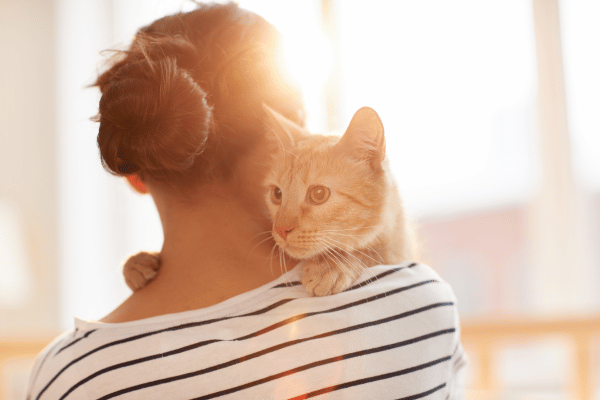Unlock the secrets of your feline friend’s actions with our guide on Understanding Cat Behavior. From playful kittens to dignified adults, learn what drives their mysterious ways.
Kitten Antics: Cute but Crucial

Watching a kitten explore its world is enchanting. These early days are more than just cute; they’re critical for development. As they pounce and play, kittens learn vital skills and boundaries, shaping their future behavior. This period is essential for socialization, teaching them how to interact with humans and other animals.
Kittens exhibit a high level of curiosity, leading them to investigate every corner of their environment. This behavior, while sometimes leading to mischief, is part of their learning process. They’re not just playing; they’re understanding their territory, testing their agility, and learning the limits of their newfound world.
As kittens grow, their playful behavior starts to evolve. The games they play become more sophisticated, reflecting their maturing instincts. This phase is crucial for owners to engage in interactive play, using toys that stimulate their hunting instincts, helping to develop a well-adjusted adult cat.
Adult Cats: Graceful Maturity
As kittens transition into adulthood, their behavior reflects their increased confidence and independence. Adult cats often exhibit a more relaxed demeanor, preferring to observe their surroundings with a composed curiosity. This shift from playful exuberance to serene observation marks their maturity. They may seek less constant play, but their affection and loyalty deepen, forming stronger bonds with their human companions.
The hunting instinct remains strong in adult cats. They might not chase after toys with the same fervor as in their youth, but they still appreciate engaging in the occasional hunt-like play. Providing stimulating activities that cater to this instinct can keep them physically and mentally sharp. Activities such as puzzle feeders or interactive toys that mimic prey movements can be particularly beneficial during this stage.
Adult cats also value their routines and territories more profoundly. They are creatures of habit, finding comfort in the predictability of their environment. Changes in their routine or living space can cause stress, so it’s crucial for owners to introduce changes gradually. Understanding and respecting this need for stability can help maintain a harmonious household and support the well-being of your feline friend.
Senior Years: Embracing the Golden Age
As cats enter their senior years, noticeable changes in behavior may emerge. They might seek out quietude more often, favoring peaceful spots for rest. This doesn’t mean they lose interest in affection or play; rather, they appreciate gentler interactions. Recognizing and adapting to these shifts in preferences is key to providing a comfortable and nurturing environment for aging felines.
Senior cats may face challenges with mobility and health, impacting their behavior. They could be less inclined to jump or climb, showing a preference for more accessible cozy spots. It’s important for owners to monitor these changes closely, ensuring their living spaces are adapted to these evolving needs, like providing steps to their favorite perch or a comfortable bed on the floor.
Despite these changes, senior cats still enjoy engaging with their environment, albeit in more subdued ways. Offering them toys that require less exertion or puzzles that stimulate their minds without taxing their bodies can contribute to their overall well-being. Understanding and respecting the evolving nature of their behavior in these golden years is crucial for maintaining their quality of life.
Navigating Behavioral Changes
Behavioral shifts in cats, regardless of age, can signal various needs or health issues. For instance, a cat that suddenly becomes more withdrawn or aggressive may be experiencing discomfort or stress. It’s essential for owners to observe these changes carefully and seek veterinary advice when necessary, ensuring any underlying issues are addressed promptly.
Communication plays a vital role in understanding and responding to a cat’s changing behaviors. Cats use a combination of vocalizations, body language, and actions to express themselves. Being attuned to these cues allows owners to better meet their feline friends’ needs, fostering a deeper bond and mutual respect between pet and caregiver.
Adaptability is key when living with cats. Their behaviors can be influenced by a myriad of factors, including age, health, and environment. By remaining observant and responsive to their cues, owners can provide the support and care needed at every life stage, ensuring a happy and healthy companionship.
Fostering a Happy Cat Environment

Creating a stimulating and safe environment is crucial for a cat’s well-being. This includes access to scratching posts, which not only keeps their claws healthy but also satisfies their instinctual need to scratch. Additionally, offering various perches and hideaways can cater to their love for climbing and exploring, as well as provide refuge when they seek solitude.
Interactive play is essential, regardless of a cat’s age. Engaging in daily play sessions with toys that mimic prey, such as feather wands or laser pointers, can enrich their lives and strengthen the bond between cat and owner. It’s a fun way to keep them physically active and mentally stimulated, contributing to their overall happiness.
Consistent routine and gentle handling are also key components of a happy cat environment. Cats thrive on predictability, so maintaining a consistent schedule for feeding, play, and cuddle times can help them feel secure. Understanding and respecting their boundaries, especially when it comes to handling and petting, ensures a respectful and loving relationship.
Health and Nutrition: Cornerstones of Behavior
A cat’s behavior is deeply influenced by its health and diet. Nutritious food that meets all their age-specific requirements can have a profound effect on their energy levels, mood, and overall well-being. Ensuring they receive the right balance of proteins, fats, and other essential nutrients is key to maintaining a healthy and active life.
Regular veterinary check-ups play a crucial role in identifying and managing health issues that could affect a cat’s behavior. Conditions such as arthritis, dental pain, or thyroid imbalances can lead to significant changes in how a cat acts. Early detection and treatment can help manage these conditions effectively, allowing cats to maintain a better quality of life.
Hydration is another critical aspect of a cat’s health that can impact behavior. Many cats are prone to low water intake, which can lead to health problems such as urinary tract infections or kidney issues. Providing fresh water daily and considering the use of a cat water fountain can encourage better hydration habits, supporting overall health and vitality.
Understanding Stress in Cats
Stress can significantly impact a cat’s behavior, leading to issues such as hiding, aggression, or changes in eating habits. Identifying the sources of stress, like changes in the household, new pets, or loud noises, is crucial for mitigating their effects. Providing a stable and serene environment can help minimize anxiety and promote a sense of security for your feline friend.
Enrichment plays a vital role in reducing stress levels in cats. This includes interactive toys, scratching posts, and opportunities for climbing and exploration. Such activities not only distract them from stressors but also fulfill their natural instincts, leading to a more content and relaxed demeanor.
For cats prone to stress, establishing a routine can provide comfort and predictability. Consistent feeding times, regular play sessions, and a quiet space for retreat can all contribute to a calmer, more confident cat. In cases of severe anxiety, consulting with a veterinarian or a feline behaviorist may be beneficial for tailored strategies to improve their well-being.
The Role of Socialization
Socialization is key to shaping a cat’s behavior towards people and other pets. Introducing cats to a variety of people, animals, and environments at an early age can greatly influence their ability to adapt and feel comfortable in different situations. Positive experiences during this critical period can lead to a well-adjusted and sociable cat.
For adult cats, continued social interaction is important to maintain their social skills and prevent behavioral issues related to fear or aggression. Engaging them in play, providing opportunities for safe outdoor exploration, or even considering a compatible feline companion can enrich their social life and enhance their well-being.
It’s crucial to respect a cat’s pace and preferences when it comes to socialization. Forcing interactions can lead to stress and fear, so it’s important to allow cats to approach new people and pets on their own terms. Positive reinforcement and patience can go a long way in building trust and a strong bond.
Enhancing Cat Behavior Understanding
Enhancing your understanding of cat behavior is a journey of observation and learning. Each cat is unique, with its own set of preferences, quirks, and ways of communicating. Paying close attention to your cat’s body language, vocalizations, and daily habits can provide valuable insights into their emotional state and needs.
Building a strong bond with your cat involves not just love, but also a deep respect for their nature and instincts. Creating a safe and stimulating environment, coupled with patience and positive interactions, can foster a trusting relationship. This bond not only enriches your lives but also makes it easier to navigate any behavioral challenges that may arise.
Remember, changes in behavior can often be the first sign of discomfort or illness, so it’s important to stay vigilant and consult with a veterinarian if you notice any unusual behaviors. By understanding and respecting the complex nature of cat behavior, you can ensure a happy, healthy life for your feline companion.
Fostering a Deeper Bond with Your Cat
In conclusion, understanding cat behavior from kittenhood to adulthood is pivotal in nurturing a harmonious relationship between you and your feline companion. Recognizing the nuances in their behavior and responding to their needs can significantly enhance their quality of life and deepen the bond you share. It’s a rewarding journey that evolves as they transition through the stages of their life.
Adapting to and respecting their changing needs, whether they’re a playful kitten, a dignified adult, or a serene senior, is key. Providing a stimulating environment, proper nutrition, regular health check-ups, and a safe space for them to retreat to is essential. Remember, every interaction with your cat is an opportunity to strengthen your connection and understand them better.
We encourage you to continue exploring and learning about cat behavior. Share your experiences and tips with our community in the comments below or visit other sections of our site for more insights. Your proactive approach to understanding and caring for your cat not only enhances their well-being but also makes every moment with them more meaningful.
I. Frequently asked questions about pet life stages
- What to consider before adopting a pet in old age?When adopting a pet in old age, it's important to consider the animal's energy level, necessary health care, and whether the senior's lifestyle can accommodate the pet's needs during its various life stages.
- How do pets behave in their final moments of life?In their final moments, pets may seek isolation, show changes in appetite or behavior, and need palliative care and comfort to ensure their last days are spent with dignity and as little discomfort as possible.
- What are the main nutritional supplements for pets?Key supplements can include omega-3 fatty acids for skin and coat health, glucosamine for joints, probiotics for digestive health, and antioxidants for immune support, varying according to the pet's life stage.
- How to deal with "hookworms" in pets?Treatment for "hookworms," caused by nematode larvae that infect the skin, includes antiparasitic medications prescribed by the veterinarian, as well as hygiene care of the environment to prevent reinfestations.
- What are the life stages of a dog and how to care for each?The life stages of a dog include puppy, juvenile, adult, and senior, and each stage requires specific care in terms of nutrition, exercise, preventive health, and attention to behavioral changes.
- What to do if your dog or cat has nightmares?If your pet has nightmares, it's important to provide a safe and comfortable sleeping environment, avoid waking them abruptly, and consult a veterinarian if the nightmares are frequent or intense, as they may indicate stress or health issues.
- How to deal with the rebellious adolescence of dogs and cats?During adolescence, which can be a rebellious phase, it's crucial to maintain a consistent routine, reinforce positive training, and provide plenty of physical and mental exercise to help manage unwanted behaviors.
- How to protect your dog from the star tick?Protection against the star tick involves regular use of antiparasitic products recommended by the veterinarian, maintaining environmental hygiene, and regular checks on the pet's fur, especially after walks in prone areas.
- Which animals undergo metamorphoses during their lives?Although the question deviates slightly from the main theme, it's interesting to note that many animals, such as butterflies, frogs, and certain types of fish, undergo significant metamorphoses during their life stages.
- What to do if your pet sheds a lot of fur?If your pet is shedding a lot of fur, it's important to maintain a regular brushing routine, consider the diet and skin health, and consult a veterinarian to rule out any underlying health issues.
- Toggle TitleToggle Content

Join Dan Morgan at dwfocus.com, your hub for ‘4 paws and owners’ wisdom! Explore a world where pet care meets expert insights, crafted by Dan, a seasoned vet with a heart for animals. Engage with stories, tips, and advice that every pet owner needs. From playful pups to graceful cats, Dan Morgan guides you through the joys and challenges of pet parenting. Embrace your love for pets with Dan’s expert guidance on dwfocus.com. #4PawsAndOwners #DanMorganPetExpert #dwfocus






